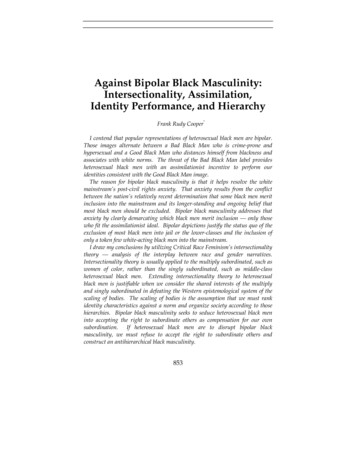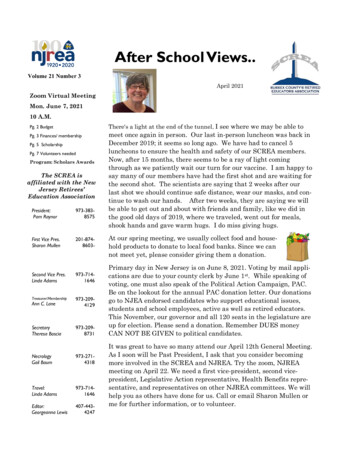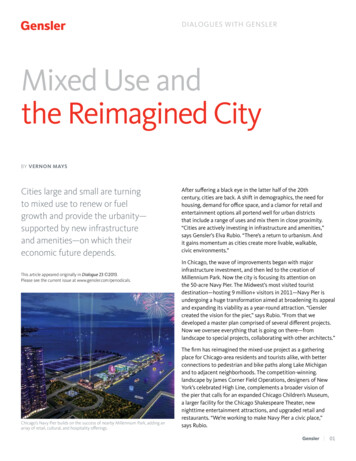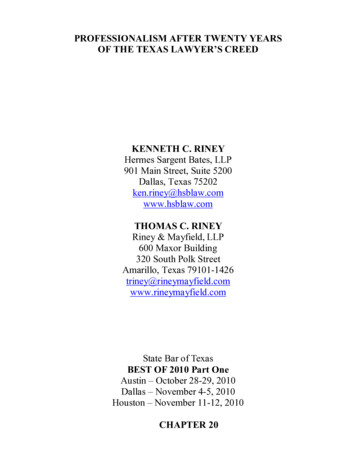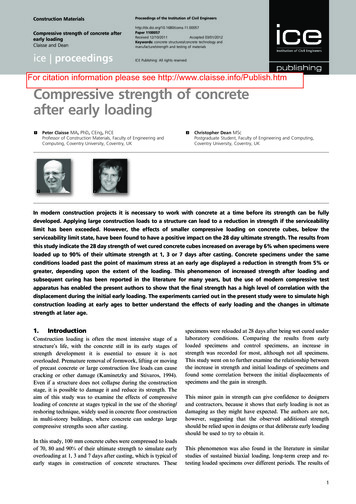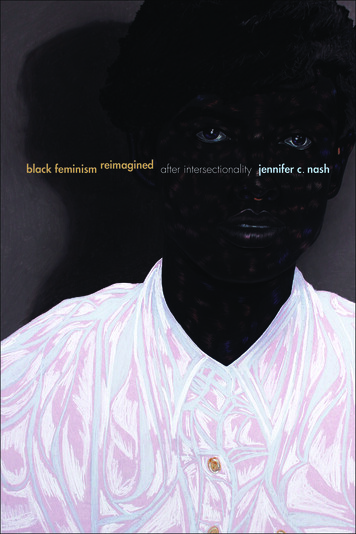
Transcription
black feminism reimagined after intersectionality jennifer c. nash
next wave New Directions in Women’s StudiesA series edited by Inderpal Grewal, Caren Kaplan, and Robyn Wiegman
jennifer c. nashblack feminism reimagined after intersectionalityDuke University PressDurham and London 2019
2019 Duke University PressAll rights reservedPrinted in the United States of America on acid-free paper Designed by Courtney Leigh Baker and typeset inWhitman and Futura by Graphic Composition, Inc., Bogart, GeorgiaLibrary of Congress Cataloging-in-Publication DataNames: Nash, Jennifer C., [date] author.Title: Black feminism reimagined : after intersectionality /Jennifer C. Nash.Description: Durham : Duke University Press, 2019. Series: Next wave Includes bibliographical references and index.Identifiers: lccn 2018026166 (print)lccn 2018034093 (ebook)isbn 9781478002253 (ebook)isbn 9781478000433 (hardcover : alk. paper)isbn 9781478000594 (pbk. : alk. paper)Subjects: lcsh: Womanism—United States. Feminism—United States. Intersectionality (Sociology) Feminist theory. Women’s studies—United States. Universities and colleges—United States—Sociological aspects.Classification: lcc hq1197 (ebook) lcc hq1197 .n37 2019(print) ddc 305.420973—dc23lc record available at https://lccn.loc.gov/2018026166cover art: Toyin Ojih Odutola, The Uncertainty Principle, 2014. Toyin Ojih Odutola.Courtesy of the artist and Jack Shainman Gallery, New York.
contentsAcknowledgments viiintroduction. feeling black feminism 11. a love letter from a critic, or noteson the intersectionality wars 332. the politics of reading 593. surrender 814. love in the time of death 111coda. some of us are tired 133Notes 139Bibliography 157Index 165
acknowledgmentsOver the course of writing this book, I moved to a new city, started a newjob, and welcomed a new life into the world. It has been a long season ofchange—both delightful and disorienting—and in the midst of it, I haveconsidered this project a reassuring constant. The poet Mary Oliver reminds us “Let me / keep my mind on what matters, / which is my work.”Every day that I have met this work, I have been reminded that it mattersbecause it has given me the freedom to ask questions, to explore, to dream,and to be in conversation with scholars whom I respect deeply.I spent six years as an assistant professor in the American Studies Department and Women’s Studies Program at George Washington University. I amdeeply grateful for the friends I made there, particularly Dara Orenstein, ChadHeap, Calvin Warren, Naeemah Raqib (the patron saint of women’s studies),Justin Mann, Kim Probolus, and the many fantastic cohorts of Varieties ofFeminist Theory. I owe Emily Hirsch extra thanks for a friendship born fromVarieties and sustained through two years of daily WhatsApps from Zambia.Tom Guglielmo is in a category of his own. He welcomed me to DC withtremendous warmth, and over the course of six years, our families becameclose friends. I am endlessly grateful for his big-heartedness and kindness andhis sense of humor. Jim Miller created a departmental culture of generosity,a healthy irreverence for university bureaucracy, and a deep appreciation forMarch Madness. He is missed. Katie Rademacher Kein is one of my most cherished friends, and I owe her thanks for so much—a deep and always-growingfriendship; Seinfeld references; daily e-mails and texts; cookies and waffles.
There isn’t a day that has passed when we haven’t talked about the smallestand biggest of things in our lives, and I am endlessly grateful for the ongoingconversation. Thanks to my new colleagues in the Department of AfricanAmerican Studies and the Gender and Sexuality Studies Program at Northwestern who have welcomed me into their community. And thanks, alwaysand deeply, to my students who remind me why I do this work. Special thanksto Mishana Garschi for her careful reading of the final draft of this manuscript, for a friendship that I cherish, and for the shared love of cookies.I have endless love and appreciation for my homegirls. Emily Owenshas given me the joy of sisterhood. I am grateful for morning check-in emails and Skype sessions; for the intellectual pleasures of our many collaborations; for the celebrations we have shared and for the hard momentswhen we have been in each other’s corner; and for all the ways that, for thelast fifteen years, we have been witnesses to each other’s lives. SamanthaPinto has read this horse more times than I can count, and always withencouragement, generosity, and her characteristic brilliance and insight. Ithank her for the extraordinary pleasure of reading, writing, and thinkingtogether; for texts and Skype sessions in the final months of this projectthat reminded me that there was something here worth saying; for hercompany, wisdom, and humor in the early years of parenting; and for allthe moments she has helped me through existential dread by knowing justhow to make me laugh. Amber Musser and I have been thinking togetherfor over a decade—about big ideas and the stuff of everyday life—and thisbook simply wouldn’t exist without her insightful and generous feedback,intellectual companionship, and treasured friendship.Thank you to a remarkable group of dear friends: Amber Musser, AmyHesse Siniscalchi, Attiya Ahmad, Emily Hirsch, Emily Owens, JonathanEvans, Nikki Kadomiya, Katie Rademacher Kein, Peter Geller, ReshmaGardner, Samantha Pinto, Sarah Jane Cervenak, Sylvanna Falcón, and TomGuglielmo. I appreciate all the lunches, dinners, cookies, teas, Scrabblegames, supportive e-mails, and Skype dates.Thanks to Sylvanna Falcón for long-distance feminist community, writing deadlines, the pleasures of collaborative writing, and many conversations on intersectionality and transnationalism. Thanks to Sarah Jane Cervenak for her deeply smart work, her generous spirit, and her generativefeedback on this manuscript.Thanks to the feminist writing circle for collegiality, smart feedback, andmuch-needed community: Attiya Ahmad, Libby Anker, Soyica Colbert, Ivyviii Acknowledgments
Ken, Bibiana Obler, Samantha Pinto. Many thanks to Attiya for her generosityin every sense of the word, her pictures and texts from far-flung places, andfor being a loving godmother to Naima. Many thanks to Ivy for her kindnessand sense of humor, her important work on intersectionality, and for ongoing conversations about mutual constitution (and for that unforgettablephrase: “death watch”).Thanks to Maria MacKnight, healer extraordinaire, for everything shedid to keep my mind and body well. Thanks to Maricela Lloreda Manzanofor lovingly caring for Naima from the very beginning, and for becomingpart of our family. Thanks to the folks who have nourished Naima’s mind,soul, and body—Kevin, Alma, Deonna, Taji, and especially Maria Pino Duran (my dear friend and comadre). This book simply wouldn’t exist withoutthe community they have made.Thanks to mentors and teachers: Nicole Fleetwood served as my mentorduring my fellowship year and gave tirelessly of her time, energy, and insightful feedback. In the many years since, she has consistently supportedme and my work. She encouraged me to think about defensiveness in relationship to black feminism and thus set me on the path that birthed thisbook. She has also modeled for me a relationship to professional life that isrooted in generosity rather than competition, abundance rather than scarcity, joy instead of anxiety. Robyn Wiegman’s work has challenged me in themost exciting ways, transforming the questions that I ask and demandingthat I interrogate my attachments to those very questions. I am thankfulfor the tremendous intellectual generosity she has shown me, the criticalquestions she has posed at just the right time, and her deep support of mywork. Sunday mornings with Ashutosh-ji Agrawal at Hindi University keptme grounded. I admire Ashu’s genuine curiosity about people and ideas, hiscommitment to spreading his love of Hindi, and his passion for teaching. Inthe midst of my first Chicago winter, Lindsey Stranc helped me stretch mybody and mind, challenging me to do things I didn’t think possible whiletalking about moocs and the Middle East bakery. I am deeply grateful.Paulo Carvalho has introduced me to the joys of the piano and encouragedme to put a “little bit of Aretha” in everything I do.The Woodrow Wilson Junior Faculty Career Enhancement Grant provided a transformative year of research leave and supportive scholarly community; Northwestern University’s Faculty Research Grant, George Washington University’s Facilitating Fund, and George Washington University’sColumbian College’s Facilitating Fund provided research support; ElizabethAcknowledgments ix
Novara at the University of Maryland Library helped me access the NationalWomen’s Studies Association’s archives. Thanks to editors and readers atSocial Text and Feminist Theory; both journals published earlier versions ofthe work here, and anonymous readers helped me sharpen my arguments.Thanks to Duke University Press, especially Ken Wissoker and ElizabethAult, who shepherded this manuscript through the review process with profound care. Duke’s review process models the best of academic life: a deepgenerosity with ideas. I owe endless thanks to the four reviewers whoserigorous, respectful, and thoughtful feedback pushed me forward in crucialdirections.Thanks to interlocutors who gave me space to try out ideas, and whoposed exciting questions of this work: at the National Women’s StudiesAssociation’s annual conference, the American Studies Association’s annualconference, University of Massachusetts Amherst (especially Svati Shah),Rice University (especially Susan Lurie), Washington University (especiallyAmber Musser), Duke University’s Feminist Theory Workshop (especiallyRobyn Wiegman), Ohio State University (especially Shannon Winnubst),the University of Michigan’s Women’s Studies Department (especially JoeyGamble) and American Culture Department (especially Stephen Molldrem),the University of California San Diego’s Ethnic Studies Department, University of Pittsburgh, the University of Toronto’s Critical Analysis of LawWorkshop, ucla’s Critical Race Studies symposium, and Barnard College’sScholar and Feminist Conference (especially Attiya Ahmad).Finally, I reserve these closing words for my family:I stand on the shoulders of dear family members who labored so thatI could have a life pursuing what I love. It is an honor to say their nameshere: Mae Thompson, Alfred Nash, Parthenia Nash, Christine Eastmond,Maurice Eastmond.Amar Ahmad and I have had a very long journey to what has become areal and treasured friendship. Because our affection is hard-earned, it is allthe more precious to me. I hope he knows that I consider it an immensegift to be his stepmother.Naima Ahmad Nash has been a loving guide to this next chapter in mylife. I owe her thanks for her patience with all I don’t yet know, her sense ofhumor, and her deep curiosity and playfulness. She has taught me to enjoybirdies, bunnies, and doggies, to take time to stare with wonder at a planeor a shadow, and to appreciate the rumble of a trash truck. It has been anx Acknowledgments
immense pleasure to see the world’s ordinary magic through her eyes, andI am endlessly grateful for her beautiful presence in my life.My parents, Carolyn and Douglas Nash, have made endless sacrifices sothat I can thrive. My mother always makes time to say “I’m so proud of you,”and my father has transformed the basement into the official Jennifer Nasharchive (it is not surprising that this archive has yet to have any visitors except, of course, for my father). They find a way to communicate their loveand affection, generosity and kindness, every single day. Thank you is fartoo small since they have given me the world, but it’s what I can offer here.Thank you, Mom and Dad, for everything.Amin Ahmad has done it all and then some. He supports me, cherishesmy intellectual life, finds humor in my quirks, unleashes my silliness, andloves me fiercely. He inspires me every day with his commitment to makingsomething beautiful with words, and with his pursuit of a creative life. Hehas traveled with me—often literally—to unfamiliar places to support mydreams, my work, and our visions of a different life, and he has done it withgrace and generosity.This project, like the one before, like the ones that will come after, is forAmin. It marks all that we have shared, and all that we share. It marks alove that grows with the years, the months, the days. It marks my unendinggratitude for him, for the universe that allowed us to find each other, andfor our love.Acknowledgments xi
introduction. feeling black feminismIn an article published in the New Yorker in 2016, Nathan Heller describedintersectionality as the heart of contemporary student activism. He writes,“If the new campus activism has a central paradigm, it is intersectionality:a theory, originating in black feminism, that sees identity-based oppressionoperating in crosshatching ways.”1 A year later, journalist Andrew Sullivan’s polemic against intersectionality was published in New York Magazine.He describes intersectionality as “the latest academic craze sweeping theAmerican academy” and likened it to a “religion,” one that produces a dangerous “orthodoxy through which all of human experience is explained—and through which all speech must be filtered.”2 If Heller envisioned intersectionality as the principle organizing campus activism, Sullivan treatedit as a dangerous “academic craze” that “enforces manners” and “controlslanguage and the very terms of discourse.”3 Both articles were largely—and correctly—condemned for representing students as hypersensitive andcoddled, and for trafficking in deep misunderstandings of intersectionality’shistories, critical and political aspirations, and roots in black feminist theory.4 Yet what interests me about the articles—and the vociferous responsesto them by scholars and activists on the US Left—is how “intersectionality,”a term that “has migrated from women’s studies journals and conferencekeynotes into everyday conversation, turning what was once highbrow discourse into hashtag chatter,” acted as the window through which to vieweither the imagined problems (or, in the case of the articles’ critics, theimagined progress) of the contemporary university.5 In some ways, it is
unsurprising that a term rooted in black women’s intellectual productionwould be figured as a dangerous space of political excess, as an ideologythat has colonized the hearts and minds of (vulnerable) college students, asthis is precisely how black women’s corporeal presences have been figured.Yet what is new, and even surprising, is the contention that intersectionality is at the center of the university’s intellectual and political life, that anunderstanding of the contemporary university requires contending withintersectionality.Black Feminism Reimagined is a project that carefully studies intersectionality’s lives in the US university. The project was born from a deep curiosityabout the variety of political and theoretical work that intersectionality iscalled upon to perform in the US academy, and in the peculiarly contentious battles that have been waged around intersectionality, battles which Iargue implicate the body that haunts the analytic—black woman—even ifshe is not always explicitly named as such. If intersectionality functions asa barometer measuring—and calibrating—the political atmosphere of theUS university, I argue that it has been most emphatically called upon to docorrective ecological work in the context of women’s studies, and that it isin relationship to academic feminism that intersectionality’s institutionallife has taken shape. Indeed, in Black Feminism Reimagined, I treat intersectionality as women’s studies’ primary program-building initiative, as itsinstitutional and ethical orientation, even as the field retains an ambivalent relationship with the analytic, always imagining it as simultaneouslypromising and dangerous, the field’s utopic future and its past tense.6 Thus,this book largely focuses on the complicated and contentious relationshipbetween intersectionality and women’s studies, arguing that studying thefield’s engagement with intersectionality allows a window into the discipline’s longer and fraught relationship with black feminist studies, and withblack feminists.7 More than that, because women’s studies has been a kindof laboratory for intersectionality’s institutional life in the US academy, understanding feminist conversations about intersectionality as the remedy,the cure, the threat, or the peril enables an understanding of the debatesthat swirl around intersectionality in the university at large.Black Feminism Reimagined explores what it has meant for black feminism—and black feminists—to have intersectionality come to occupy the center of women’s studies and to migrate across disciplinary boundaries, to beboth filled with promise and emptied of specific meaning. I ask how blackfeminists have made visible their collective feelings about intersectionality’s2 Introduction
“citational ubiquity” in and beyond women’s studies, and about the blackfeminist affects that attend to the variety of hopes and perils that have beenimaginatively tethered to the analytic.8 Thus, I imagine black feminism asan affective project—a felt experience—as much as it is an intellectual, theoretical, creative, political, and spiritual tradition. Black Feminism Reimagined argues that there is a single affect that has come to mark contemporaryacademic black feminist practice: defensiveness. I treat black feminist defensiveness as manifested most explicitly through black feminism’s proprietary attachments to intersectionality. These attachments conscript blackfeminism into a largely protective posture, leaving black feminists mired inpolicing intersectionality’s usages, demanding that intersectionality remainlocated within black feminism, and reasserting intersectionality’s “true”origins in black feminist texts. This book traces how defensiveness is largelyarticulated by rendering intersectionality black feminist property, as terrainthat has been gentrified, colonized, and appropriated, and as territory thatmust be guarded and protected through the requisite black feminist vigilance, care, and “stewardship.”9 The project develops the term “holding on”to flag—and to unsettle—the set of practices that defensiveness unleashes,particularly the proprietary claim to intersectionality that continues to animate so much of black feminist engagement with intersectionality. In treating defensiveness as a defining black feminist affect, my intention is notto diagnose individual black feminists as defensive or to pathologize blackfeminist feelings. Nor is my impulse to ignore histories of antiblackness andmisogyny—including the invisible labor of black women inside the academy that, quite literally, kills black female academics—that render blackfeminist defensiveness a political response to ongoing violence. I seek toethically attend to that history even as I critique the proprietary impulsesof black feminism in an effort to reveal how the defensive affect traps blackfeminism, hindering its visionary world-making capacities. If “holding on”describes the set of black feminist practices this project seeks to disrupt,“letting go” represents the political and theoretical worldview this projectadvances, a vision of black feminist theory that is not invested in makingproperty of knowledge.This book also argues that it is impossible to theorize black feminist defensiveness without a rigorous consideration of the place of black feministtheory generally, and intersectionality specifically, in women’s studies. BlackFeminism Reimagined situates black feminist defensiveness in the context ofUS women’s studies, an interdiscipline that is organized around the symbolFeeling Black Feminism 3
of black woman even as the field retains little interest in the materialityof black women’s bodies, the complexity of black women’s experiences, orthe heterogeneity of black women’s intellectual and creative production.Defensiveness emerges precisely because the symbol of black woman isincessantly called upon to perform intellectual, political, and affective service work for women’s studies, much as black female faculty are called uponto perform diversity service work in women’s studies and across the university.10 This particular form of feminist service work is evident in thegeneral sentiment that women’s studies can be remedied—or already hasbeen remedied—through the incorporation of black feminist theory intothe field’s canon, through the hailing of black feminist theory as the remedyto (white) feminism’s ills, or through the ways that black female facultyare called upon to embody and perform the field’s transformation. RachelLee captures how women of color are rhetorically summoned as proofof the field’s evolution, noting “women of color remain eminently usefulto the progress narrative Women’s Studies wishes to create for itself, wherethe fullness of women of color’s arrival within Women’s Studies is always‘about to be.’”11 Thus, black woman serves the discipline’s “progress narrative,” acting as a sign of how much the discipline has overcome its pastexclusions and how deeply the discipline refuses so-called white feminism,and intersectionality’s ubiquity in women’s studies is often taken as evidence of how black feminism has transformed the discipline.12 While thisbook remains deeply invested in a consideration of black feminism’s relationship to the university generally, and to women’s studies specifically, itis crucial to note that black feminism—and black feminists—have longbeen attached, optimistically or self-destructively (or maybe both)—to theuniversity. Indeed, black feminist theory has a long history of both trackingthe violence the university has inflicted on black female academics (oftenby demanding black women’s labor—intellectual, political, and embodiedlabor) and advocating for institutional visibility and legibility. While blackfeminists have long traced the violence of the university, few have advocatedfor abandoning the institutional project of black feminism, despite longstanding and widely circulating texts theorizing how the academy quiteliterally cannibalizes black women, extracts their labor, and renders invisible the work they perform to establish fields. Thus, when I consider theviolence the university has inflicted on black women’s bodies, I want tounderscore that black feminism has remained oriented toward the university despite this violence, and has largely retained a faith in the institution’s4 Introduction
capacity to be remade, reimagined, or reinvented in ways that will do lessviolence to black feminist theory and black feminists’ bodies.In naming defensiveness as a defining black feminist affect, Black Feminism Reimagined necessarily makes a claim about what constitutes blackfeminism. I treat black feminism as a varied project with theoretical, political, activist, intellectual, erotic, ethical, and creative dimensions; blackfeminism is multiple, myriad, shifting, and unfolding. To speak of it in thesingular is always to reduce its complexity, to neglect its internal debates andits rich and varied approaches to questions of black women’s personhood.I treat the word “black” in front of “feminism” not as a marker of identitybut as a political category, and I understand a “black feminist” approachto be one that centers analyses of racialized sexisms and homophobia, andthat foregrounds black women as intellectual producers, as creative agents,as political subjects, and as “freedom dreamers” even as the content andcontours of those dreams vary.13 I advance a conception of black feminismthat is expansive, welcoming anyone with an investment in black women’shumanity, intellectual labor, and political visionary work, anyone with aninvestment in theorizing black genders and sexualities in complex and nuanced ways. My archive of black feminist theorists includes black, white, andnonblack scholars of color who labor in and adjacent to black feminist theory. My contention is that these varied black feminist scholars can all speakon and for black feminist theory, and as black feminist theorists, even as theymake their claims from different identity locations. To be clear, my capacious conception of black feminism is a political decision, one that is stagedmindful of black feminists’ long-standing critique of how the university“disappears” black women.14 Shifting the content of black feminism from adescription of bodies to modes of intellectual production might generate precisely the anxious defensiveness this book describes and aspires to unsettle.Nonetheless, I invest in a broad conception of black feminism—and blackfeminists—precisely because of my commitment to tracing black feministtheory’s expansive intellectual, political, ethical, and creative reach, one thatI see as always transcending attempts to limit the tradition by rooting it inembodied performances. Moreover, it is the ongoing conception that blackfeminism is the exclusive territory of black women that traps and limits blackfeminists and black women academics who continue to be conscripted intoperforming and embodying their intellectual investments.The introduction unfolds in three parts. First, I offer an intellectual historyof intersectionality. Then I turn to an institutional history of intersectionalityFeeling Black Feminism 5
with a focus on the term’s relationship to women’s studies. In this section, Imake explicit the book’s decision to root itself in US women’s studies evenas intersectionality specifically and black feminism more broadly have intimate connections to other interdisciplinary projects, particularly blackstudies. Finally, I turn to explicating black feminist defensiveness and tosituating this crucial and relatively new affect in the context of what I termthe “intersectionality wars.”Intersectionality: An Intellectual HistoryIn 2007, Ange-Marie Hancock noted, “A comprehensive intellectual history of intersectionality has yet to be published, with . . . significant ramifications that affect scholars seeking to conduct intersectional research andthose seeking to understand the intellectual contributions of intersectionality.”15 In the decade since Hancock’s assertion, a number of scholars, including Brittney Cooper, Vivian May, Patricia Hill Collins, Sirma Bilge, andAnna Carastathis, have invested in historicizing intersectionality as a keystrategy for understanding the term’s varied disciplinary genealogies andinterdisciplinary migrations. In my earlier work, I criticized the historicalturn in intersectionality studies, suggesting that it is often undergirded bya search for a “true” intersectionality or by an attachment to a fictive pastwhen intersectionality was practiced in ways that more “correctly” alignwith its foundational texts. As I argued, “The impulse toward historicizationall too often becomes a battle over origin stories, a struggle to determine who‘made’ intersectionality, and thus who deserves the ‘credit’ for coining theterm, rather than a rich engagement with intersectionality’s multiple genealogies in both black feminist and women of color feminist traditions.”16 Thus,I enter the terrain of historicizing intersectionality with a sense of cautionand an awareness of the potential risks of fetishizing history as the preferableorientation toward understanding intersectionality’s varied work. Here, I offer an intellectual history of intersectionality that emphasizes that intersectionality is part of a cohort of terms that black feminists created in order toanalyze the interconnectedness of structures of domination. In other words,as Deborah King notes, “The necessity of addressing all oppressions is one ofthe hallmarks of black feminist thought,” even as intersectional thinking hasunfolded around different keywords, analytics, and theories.17While intersectional histories have long included Combahee River Collective, Kimberlé Crenshaw, Patricia Hill Collins, Deborah King, and Frances6 Introduction
Beal, recent black feminist scholarship has centered Anna Julia Cooper’swork as foundational to modern intersectionality theory. In many ways,Vivian May’s scholarship ushered in a deep feminist investment in Cooper’swork as a kind of intersectional praxis, one that has been taken up by otherscholars like Brittney Cooper, who has advocated for Anna Julia Cooper’splace in a genealogy of “race women,” of black female intellectuals.18 ForMay, centering Anna Julia Cooper is not only a crucial corrective to feministhistoriographies that treat intersectionality as a “recent form” of feministengagement but also a project of feminist education that makes visible thelong intellectual and political labor of black women.19 Indeed, May readsCooper’s A Voice from the South (1892) as “the first book-length exampleof black feminist theory in the US” that “tackles the racialized, gendered,and classed meanings of personhood and citizenship,” and thus as an earlyarticulation of intersectionality theory.20 As May indicates, “Repeatedly, Ihave found that an inadequate understanding of intersectionality, even in itscontemporary iterations, means that Cooper’s innovative ideas and complexanalyses are widely misunderstood. While Cooper articulates how race, gender, class, and region (and later, nation) interdepend and cannot be examined as isolated, many of her contemporaries and later scholars examiningher work could not seem to fully grasp her arguments—in large part becauseCooper’s words and ideas were examined via single-axis frameworks, either/or models of thought, or measures of rationality that could not account formultiplicity
ment and Women’s Studies Program at George Washington University. I am deeply grateful for the friends I made there, particularly Dara Orenstein, Chad Heap, Calvin Warren, Naeemah Raqib (the patron saint of women’s studies), Justin Mann, Kim Probolus, and th
